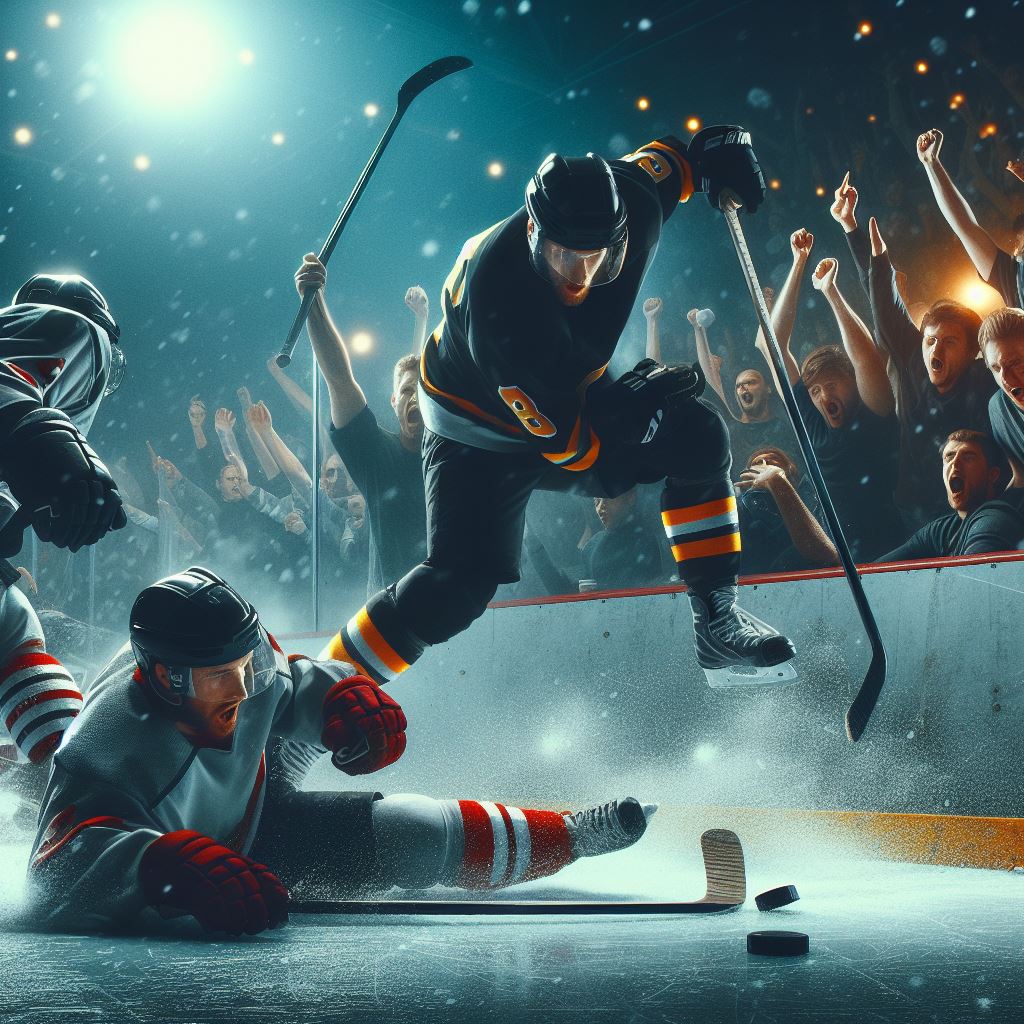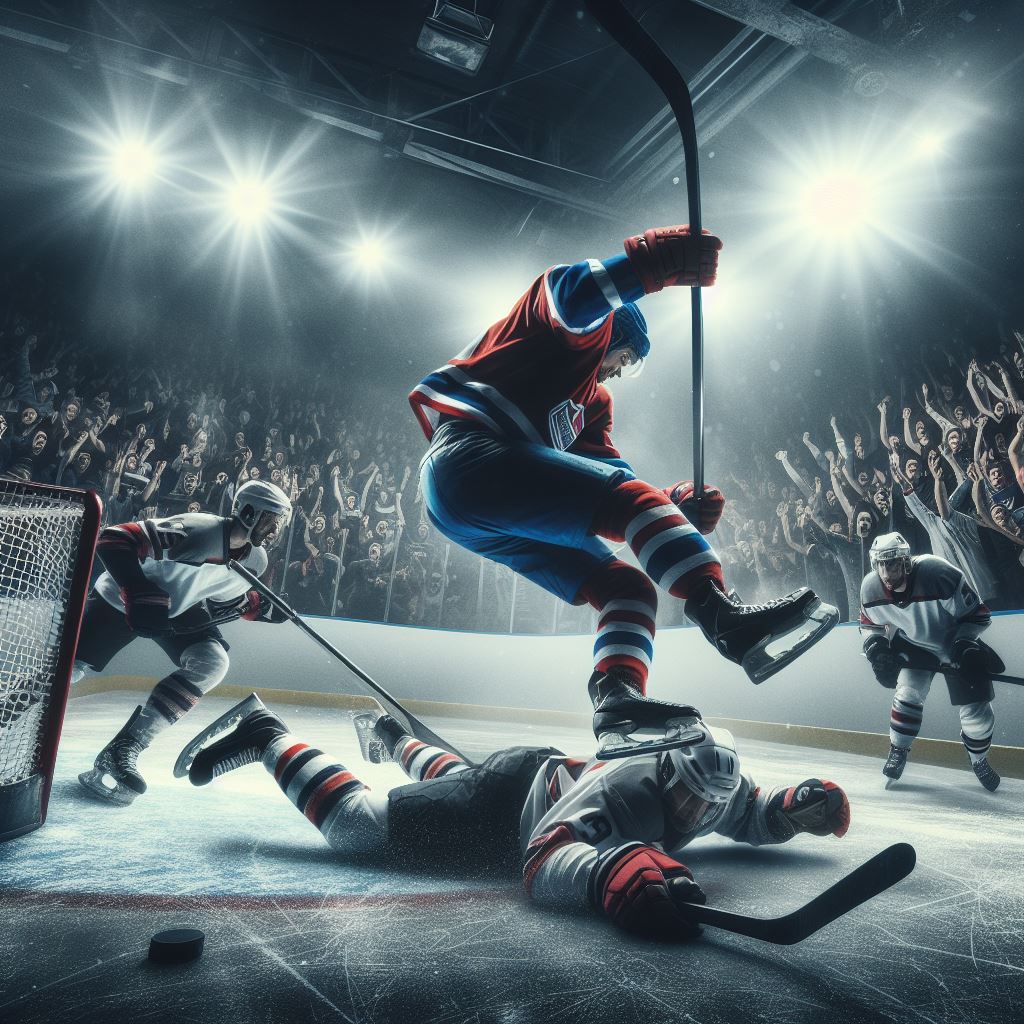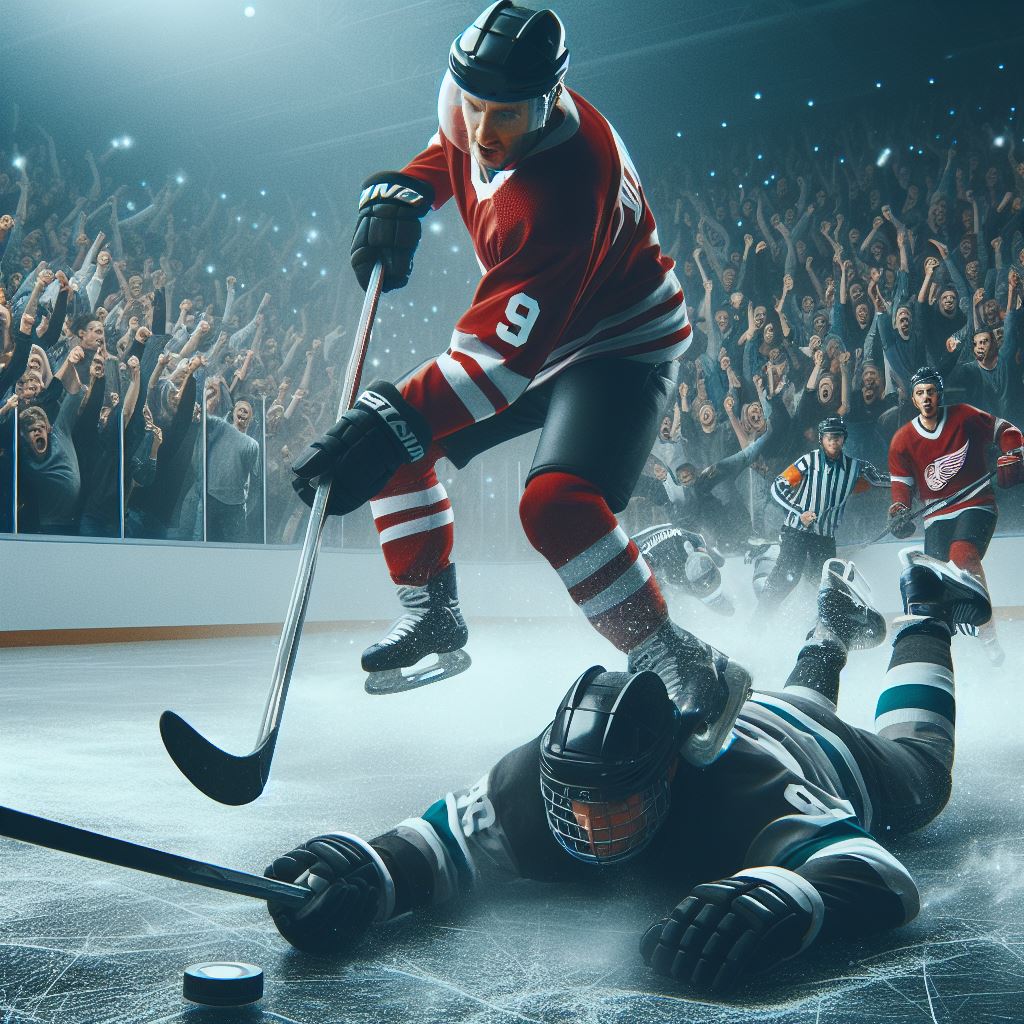“Hockey Tripping Penalty” refers to an infraction in the sport of hockey where a player uses their stick, body, or equipment to cause an opponent to lose balance and fall to the ice intentionally or recklessly. This results in the penalized player being sent to the penalty box for a specified duration, leading to their team being shorthanded. Tripping penalties are governed by official rules and regulations set forth by hockey governing bodies to ensure fair play and player safety on the ice.
Introduction
Introducing the concept of the “Hockey Tripping Penalty,” this article delves into the intricate dynamics of this infraction within the realm of hockey. When a player strategically or recklessly causes an opponent to lose balance and fall to the ice, it triggers a sequence of events, leading to penalties and gameplay disruptions.
These penalties, governed by strict regulations set forth by hockey governing bodies, not only affect the penalized player but also have profound implications for team dynamics and game outcomes. With a focus on fair play and player safety, the enforcement of tripping penalties underscores the commitment of hockey authorities to uphold the integrity of the sport while ensuring a level playing field for all participants.
What Is Hockey Tripping Penalty?
A hockey tripping penalty refers to a situation in which a player uses their stick, body, or equipment to cause an opponent to lose balance and fall to the ice intentionally or recklessly. When such an infraction occurs, the offending player is typically penalized by being sent to the penalty box for a designated time, during which their team must play shorthanded.
This penalty disrupts gameplay and often results in the opposing team gaining a power play opportunity, which can significantly impact the momentum and outcome of the game. Tripping penalties are enforced to uphold fair play and player safety, ensuring that all participants adhere to the rules and regulations of the sport.
Understanding Tripping in Hockey
Explanation of What Constitutes a Tripping Penalty
In hockey, a tripping penalty occurs when a player uses their stick, body, or any other part of their equipment to cause an opponent to lose their balance and fall to the ice. The referee must deem the action as intentional or reckless to warrant a tripping penalty. However, it’s essential to note that tripping can also occur without direct contact between players, such as when a player uses their stick to sweep an opponent’s legs out from under them.
The key element in determining whether a tripping penalty should be called lies in the intentionality of the action. If a player’s actions are deemed accidental or incidental, they may not be penalized for tripping. However, if a player makes a deliberate attempt to impede the progress of an opponent by tripping them, the referees are likely to assess a penalty.
Examples of Tripping Infractions in Hockey
Tripping can manifest in various forms on the ice, each presenting its own set of challenges for players and officials alike. Some common examples of tripping infractions include:
- Stick Tripping. When a player uses their stick to sweep or hook an opponent’s legs, causing them to fall.
- Body Tripping. This occurs when a player uses their body to obstruct an opponent’s path, leading to a fall.
- Footwork Tripping. Involves a player deliberately positioning their feet in a manner that causes an opponent to trip over them.
- Equipment Tripping. Instances where a player’s equipment, such as a skate blade or glove, makes contact with an opponent’s legs, resulting in a fall.
These examples illustrate the diverse ways in which tripping infractions can occur during a hockey game, highlighting the need for referees to exercise sound judgment in assessing penalties.

Differentiating Between Accidental and Intentional Tripping
One of the challenges faced by officials is distinguishing between accidental and intentional tripping. Accidental tripping may occur during the natural course of play, such as when players jostle for position or collide while pursuing the puck. In such cases, referees may opt not to penalize the players involved, recognizing that the tripping was unintended.
On the other hand, intentional tripping involves a deliberate act by a player to impede the progress of an opponent unfairly. This could include actions such as extending a leg to trip an opposing player or using the stick in a sweeping motion to knock an opponent off balance. Referees are trained to identify these deliberate infractions and penalize the responsible player accordingly.
Rules and Regulations of Tripping Penalties in Hockey
Official Rules Regarding Tripping Penalties in Hockey
The official rules of hockey, as outlined by governing bodies such as the International Ice Hockey Federation (IIHF) and the National Hockey League (NHL), provide clear guidelines on what constitutes a tripping penalty. According to these rules, a tripping penalty occurs when a player uses their stick, body, or any other part of their equipment to cause an opponent to lose balance and fall to the ice. The action must be deemed intentional or reckless by the referee to warrant a penalty.
Furthermore, the rules specify that tripping penalties can result from both direct and indirect contact between players. For instance, using the stick to sweep an opponent’s legs or positioning one’s body to obstruct an opponent’s path can lead to tripping penalties.
Referee Discretion and Judgment in Calling Tripping Penalties
While the rules provide a framework for identifying tripping infractions, referees play a critical role in interpreting and enforcing these rules during a game. Referees are tasked with making split-second decisions amidst the fluidity of play, relying on their experience, expertise, and understanding of the game to determine whether a tripping penalty should be assessed.
Referees exercise discretion in assessing tripping penalties based on various factors, including the severity of the infraction, the intent of the player involved, and the impact on the flow of the game. Moreover, referees may consult with other officials or utilize video review systems to ensure the accuracy of their calls.
Consequences for Committing a Tripping Penalty
Players who commit tripping infractions face immediate consequences in the form of penalties, which can impact both their team and the game as a whole. Depending on the severity of the infraction, tripping penalties may result in varying degrees of punishment, including
- Minor Penalty. Typically, minor tripping penalties result in the offending player being sent to the penalty box for two minutes, during which their team must play shorthanded.
- Major Penalty. In cases of more severe or dangerous tripping infractions, referees may assess a major penalty, resulting in the player being ejected from the game for five minutes.
- Game Misconduct. In egregious instances of tripping, referees may opt to issue a game misconduct penalty, which not only ejects the player from the current game but may also carry additional disciplinary measures, such as fines or suspensions.
Furthermore, repeated tripping infractions by a player or team may lead to further disciplinary action from league authorities, including escalating fines or suspensions.

Unraveling the Impact of Tripping Penalties in Hockey
Effects of Tripping Penalties on Gameplay
Tripping penalties disrupt the rhythm and momentum of a hockey game, creating opportunities for both teams to capitalize or defend against the ensuing power play. Here are some key effects of tripping penalties on gameplay
Power Play Advantage
When a player is assessed a tripping penalty, their team is forced to play shorthanded for the duration of the penalty. This grants the opposing team a numerical advantage on the ice, increasing their chances of scoring goals.
Increased Pressure
The team on the power play often exerts significant pressure on the shorthanded team, maintaining possession of the puck and generating scoring opportunities through increased offensive zone time.
Defensive Adjustments
Teams penalized for tripping must adjust their defensive strategies to mitigate the opposing team’s offensive onslaught. This may involve collapsing around the net, blocking shots, and aggressively pursuing puck carriers to disrupt scoring attempts.
Momentum Swings
Tripping penalties can swing momentum in favor of either team. A successful penalty kill by the shorthanded team can energize players and fans, while a power play goal by the opposing team can deflate morale and shift momentum against the penalized team.
Strategic Implications for Teams Involved
Tripping penalties force teams to adapt their strategies on the fly, both offensively and defensively. Here’s how tripping penalties impact strategic decision-making: Teams must prioritize special teams practice and execution to capitalize on power play opportunities and minimize the impact of penalties on their own game.
When shorthanded due to a tripping penalty, teams employ specific penalty kill strategies, such as aggressive forechecking, shot-blocking, and maintaining tight defensive coverage to thwart the opposing team’s attack. Coaches emphasize discipline and awareness to players to minimize tripping infractions, as penalties can often prove costly in critical moments of a game.
Momentum Shifts Resulting from Tripping Penalties
Tripping penalties can serve as pivotal moments in a hockey game, catalyzing momentum shifts that can ultimately influence the outcome. Consider the following factors contributing to momentum swings
- Emotional Response. Tripping penalties evoke emotional responses from players, coaches, and fans, amplifying the intensity and energy levels on the ice and in the arena.
- Game Context. The timing of a tripping penalty can significantly impact momentum. A penalty late in a close game may have a more pronounced effect on momentum compared to one assessed during a less critical juncture.
- Execution Under Pressure. Teams must execute effectively during power play and penalty kill situations, as successful execution can swing momentum in their favor, while failure to capitalize may embolden the opposing team.
Promoting Player Safety and Fair Play
Importance of Penalizing Dangerous Plays such as Tripping
Player safety is of paramount importance in hockey, and penalizing dangerous plays such as tripping serves to protect the well-being of players on the ice. Here’s why penalizing tripping is crucial
Preventing Injury
Tripping infractions can lead to players falling awkwardly or colliding with the boards, resulting in injuries ranging from minor bruises to more severe concussions or fractures. Penalizing tripping helps mitigate the risk of such injuries.
Deterrence of Dangerous Behavior
By penalizing tripping, referees send a clear message that dangerous plays will not be tolerated, discouraging players from engaging in reckless or intentional actions that endanger themselves and others.
Preserving the Integrity of the Game
Enforcing penalties for infractions like tripping preserves the integrity of the game by ensuring that success is achieved through skill, strategy, and fair competition, rather than through unsportsmanlike or dangerous tactics.

Role of Tripping Penalties in Promoting Fair Competition
Tripping penalties contribute to the equitable and fair nature of hockey competition in several ways
- Leveling the Playing Field. Penalizing tripping ensures that teams compete on equal terms, as both sides must abide by the same rules and regulations governing player conduct.
- Rewarding Skill and Sportsmanship. Tripping penalties penalize actions that circumvent fair play and sportsmanship, rewarding teams that excel through skillful play and adherence to the rules.
- Fostering Respect for the Game. Upholding the rules, including penalizing tripping infractions, fosters a culture of respect for the game, opponents, and officials, reinforcing the values of sportsmanship and integrity.
Measures Taken to Minimize Tripping Incidents and Ensure Player Safety
To minimize tripping incidents and enhance player safety, hockey organizations, and governing bodies implement various measures and initiatives
- Education and Training. Players, coaches, and officials receive education and training on proper playing techniques, sportsmanship, and the rules of the game, including guidelines for avoiding tripping infractions.
- Equipment Standards. Ensuring that players wear appropriate safety equipment, such as helmets, pads, and properly maintained skates, helps mitigate the risk of injury in the event of a fall or collision resulting from a tripping infraction.
- Rule Enforcement. Consistent and vigilant enforcement of tripping penalties by referees reinforces the importance of player safety and fair competition, deterring players from engaging in dangerous or unsportsmanlike behavior.
FAQs
What exactly constitutes a tripping penalty in hockey?
A tripping penalty in hockey occurs when a player uses their stick, body, or equipment to cause an opponent to lose balance and fall to the ice intentionally or recklessly.
What are the consequences of committing a tripping penalty?
Players who commit tripping infractions face penalties, ranging from minor penalties resulting in two-minute shorthanded situations to major penalties leading to ejection from the game. Repeat infractions may result in further disciplinary action from league authorities.
How do tripping penalties impact gameplay and momentum shifts?
Tripping penalties disrupt gameplay and often lead to power play opportunities for the opposing team, creating momentum swings that can significantly influence the outcome of the game.
What role do tripping penalties play in promoting player safety and fair competition?
Tripping penalties are essential for upholding player safety and fair competition by penalizing dangerous plays, discouraging reckless behavior, and ensuring that success is achieved through skill and sportsmanship.
What measures are taken to minimize tripping incidents and ensure player safety?
To enhance player safety, hockey organizations implement measures such as education and training on proper techniques, enforcing equipment standards, and consistent enforcement of tripping penalties by referees to deter dangerous behavior on the ice.
Conclusion
In conclusion, the hockey tripping penalty serves as a critical component in maintaining the integrity and safety of the sport. Defined by deliberate or reckless actions resulting in an opponent’s loss of balance, tripping infractions carry consequences that extend beyond the penalized player to impact team dynamics and gameplay momentum. Through adherence to official rules and regulations, coupled with the discretion of referees in judgment calls, hockey aims to promote fair competition and player safety on the ice.
Moreover, initiatives aimed at education, equipment standards, and consistent enforcement of penalties underscore the commitment to minimizing tripping incidents and fostering a culture of respect and sportsmanship within the sport of hockey.
